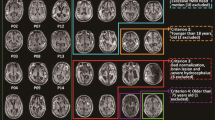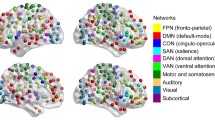Abstract
Purpose
It is always challenging to correctly differentiate between minimally conscious state (MCS) and vegetative state/unresponsive wakefulness syndrome (VS/UWS) among disorders of consciousness (DOC) patients. However, the underlying neural mechanisms of awareness identification remain incompletely understood.
Methods
Using regional homogeneity (ReHo) analysis, we evaluated how regional connectivity of brain regions is disrupted in MCS and VS/UWS patients. Resting-state functional magnetic resonance imaging was conducted in 14 MCS patients, 25 VS/UWS patients, and 30 age-matched healthy individuals.
Results
We found that MCS and VS/UWS patients demonstrated DOC-dependent reduced ReHo within widespread brain regions including posterior cingulate cortices (PCC), medial prefrontal cortices (mPFC), and bilateral fronto-parieto-temporal cortices and showed increased ReHo in limbic structures. Moreover, a positive correlation between Coma Recovery Scale-Revised (CRS-R) total scores and reduced ReHo in the left precuneus was observed in VS/UWS patients, despite the linear trend was not found in MCS patients. In addition, ReHo were also observed reduced in three mainly intrinsic connectivity networks (ICNs), including default mode network (DMN), executive control network (ECN), and salience network (SN). Notably, as the clinical symptoms of consciousness disorders worsen from MCS to VS/UWS, ReHo in dorsal DMN, left ECN, and posterior SN became significantly reduced.
Conclusion
These findings make a further understanding of the underlying neural mechanism of regional connectivity among DOC patients and provide additional neuroimaging-based biomarkers for the clinical diagnosis of MCS and VS/UWS patients.


Similar content being viewed by others

References
Giacino JT, Fins JJ, Laureys S, Schiff ND (2014) Disorders of consciousness after acquired brain injury: the state of the science. Nat Rev Neurol 10(2):99–114
Laureys S, Celesia GG, Cohadon F et al (2010) Unresponsive wakefulness syndrome: a new name for the vegetative state or apallic syndrome. BMC Med 8:68
Giacino JT, Ashwal S, Childs N et al (2002) The minimally conscious state: definition and diagnostic criteria. Neurology 58(3):349–353
Bodien YG, Chatelle C, Edlow BL (2017) Functional networks in disorders of consciousness. Semin Neurol 37(5):485–502
Vanhaudenhuyse A, Noirhomme Q, Tshibanda LJ et al (2010) Default network connectivity reflects the level of consciousness in non-communicative brain-damaged patients. Brain 133(Pt 1):161–171
Soddu A, Vanhaudenhuyse A, Bahri MA et al (2012) Identifying the default-mode component in spatial IC analyses of patients with disorders of consciousness. Hum Brain Mapp 33(4):778–796
Qin P, Wu X, Huang Z et al (2015) How are different neural networks related to consciousness. Ann Neurol 78(4):594–605
Wu X, Zou Q, Hu J et al (2015) Intrinsic functional connectivity patterns predict consciousness level and recovery outcome in acquired brain injury. J Neurosci 35(37):12932–12946
Chen S, Wu X, Wang L et al (2018) Disrupted interactions between arousal and cortical awareness networks in MCS and VS/UWS patients: evidence from resting-state functional imaging connectivity. Neuroscience 382:115–124
Boly M, Tshibanda L, Vanhaudenhuyse A et al (2009) Functional connectivity in the default network during resting state is preserved in a vegetative but not in a brain dead patient. Hum Brain Mapp 30(8):2393–2400
Zang Y, Jiang T, Lu Y, He Y, Tian L (2004) Regional homogeneity approach to fMRI data analysis. Neuroimage 22(1):394–400
Vanhaudenhuyse A, Demertzi A, Schabus M et al (2011) Two distinct neuronal networks mediate the awareness of environment and of self. J Cogn Neurosci 23(3):570–578
Demertzi A, Soddu A, Laureys S (2013) Consciousness supporting networks. Curr Opin Neurobiol 23(2):239–244
Shirer WR, Ryali S, Rykhlevskaia E, Menon V, Greicius MD (2012) Decoding subject-driven cognitive states with whole-brain connectivity patterns. Cereb Cortex 22(1):158–165
Laureys S, Goldman S, Phillips C et al (1999) Impaired effective cortical connectivity in vegetative state: preliminary investigation using PET. Neuroimage 9(4):377–382
Laureys S, Lemaire C, Maquet P, Phillips C, Franck G (1999) Cerebral metabolism during vegetative state and after recovery to consciousness. J Neurol Neurosurg Psychiatry 67(1):121
Nakayama N, Okumura A, Shinoda J, Nakashima T, Iwama T (2006) Relationship between regional cerebral metabolism and consciousness disturbance in traumatic diffuse brain injury without large focal lesions: an FDG-PET study with statistical parametric mapping analysis. J Neurol Neurosurg Psychiatry 77(7):856–862
Di Perri C, Bastianello S, Bartsch AJ et al (2013) Limbic hyperconnectivity in the vegetative state. Neurology 81(16):1417–1424
Greicius MD, Krasnow B, Reiss AL, Menon V (2003) Functional connectivity in the resting brain: a network analysis of the default mode hypothesis. Proc Natl Acad Sci U S A 100(1):253–258
Corrigan JD, Smith-Knapp K, Granger CV (1997) Validity of the functional independence measure for persons with traumatic brain injury. Arch Phys Med Rehabil 78(8):828–834
Hannawi Y, Lindquist MA, Caffo BS, Sair HI, Stevens RD (2015) Resting brain activity in disorders of consciousness: a systematic review and meta-analysis. Neurology 84(12):1272–1280
Corbetta M, Shulman GL (2002) Control of goal-directed and stimulus-driven attention in the brain. Nat Rev Neurosci 3(3):201–215
Corbetta M, Shulman GL (2011) Spatial neglect and attention networks. Annu Rev Neurosci 34:569–599
Rounis E, Yarrow K, Rothwell JC (2007) Effects of rTMS conditioning over the fronto-parietal network on motor versus visual attention. J Cogn Neurosci 19(3):513–524
Cazzoli D, Chechlacz M (2017) A matter of hand: causal links between hand dominance, structural organization of fronto-parietal attention networks, and variability in behavioural responses to transcranial magnetic stimulation. Cortex 86:230–246
Sridharan D, Levitin DJ, Menon V (2008) A critical role for the right fronto-insular cortex in switching between central-executive and default-mode networks. Proc Natl Acad Sci U S A 105(34):12569–12574
Dunlop K, Hanlon CA, Downar J (2017) Noninvasive brain stimulation treatments for addiction and major depression. Ann N Y Acad Sci 1394(1):31–54
Boerwinkle VL, Torrisi SJ, Foldes ST et al (2019) Resting-state fMRI in disorders of consciousness to facilitate early therapeutic intervention. Neurol Clin Pract 9(4):e33–e35
Acknowledgements
None.
Funding
The authors did not receive support from any organization for the submitted work.
Author information
Authors and Affiliations
Corresponding author
Ethics declarations
Conflict of interest statement
The authors declare no competing interests.
Ethics approval
Ethical approval was waived by the local Ethics Committee of Seventh Medical Center of Chinese PLA General Hospital in view of the retrospective nature of the study, and all the procedures being performed were part of the routine care.
Consent to participate
Informed consent was obtained from healthy volunteers and from the legal surrogate of each patient included in the study.
Consent for publication
The authors affirm that human research participants provided informed consent for publication of the images in Figs. 1 and 2.
Additional information
Publisher's Note
Springer Nature remains neutral with regard to jurisdictional claims in published maps and institutional affiliations.
Rights and permissions
About this article
Cite this article
Wang, Y., Li, Y., Ma, X. et al. Regional Homogeneity Alterations in Patients with Impaired Consciousness. An Observational Resting-State fMRI Study. Neuroradiology 64, 1391–1399 (2022). https://doi.org/10.1007/s00234-022-02911-2
Received:
Accepted:
Published:
Issue Date:
DOI: https://doi.org/10.1007/s00234-022-02911-2



